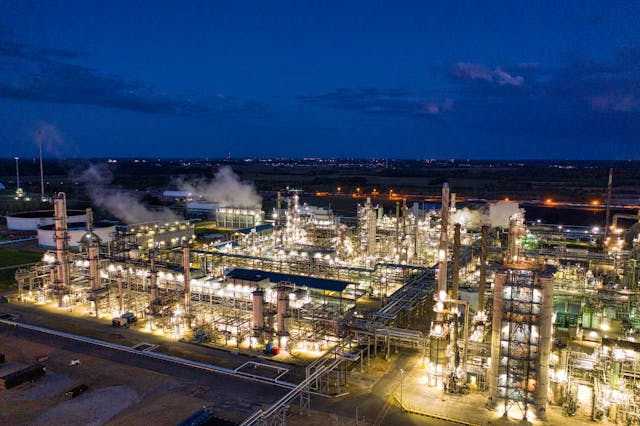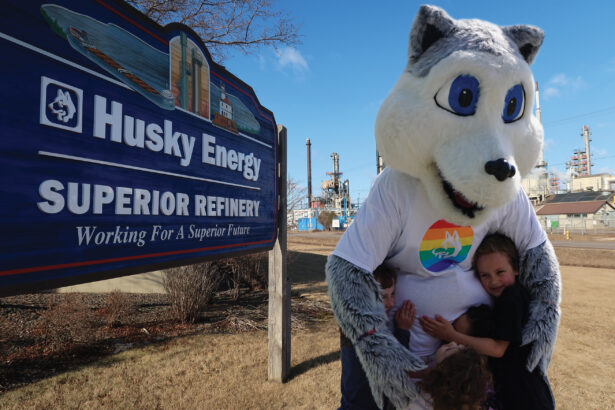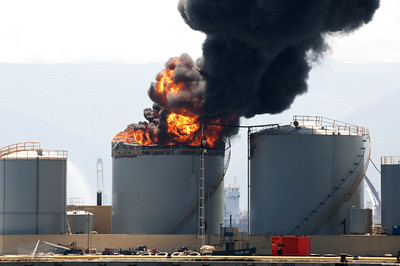
First Major U.S. Refinery Built in 50 Years Sited for Texas
Editor’s note: Brownsville, Texas – “Element Fuels has received the necessary permitting to construct and operate a refinery capable of producing in excess of 160,000 barrels, or approximately 6.7 million gallons, per day of finished gasoline, diesel, and jet fuel,” said Founder and Co-CEO John Calce. “A permit for a greenfield refinery of this size, scope, and functionality has not been granted in the United States since the 1970’s. This speaks to the innovative approaches we are taking to address climate and sustainability concerns in cleaner, greener ways that are new to the refinery space.”
Though Marathon was built in 1976, it is considered the last significant oil refinery built in the United States.
That’s partly because of community opposition to new refineries, a position that people in Garyville understood well last month.
“It’s hard to explain the mixed emotions that come with living in the conditions that we have been forced to live in here,” said Robert Taylor, who lives in the vicinity of the plant, in the community of Reserve. “Why are we designated as a sacrifice zone?”
“Though Marathon was built in 1976, it is considered the last significant oil refinery built in the United States.
That’s partly because of community opposition to new refineries, a position that people in Garyville understood well last month.
“It’s hard to explain the mixed emotions that come with living in the conditions that we have been forced to live in here,” said Robert Taylor, who lives in the vicinity of the plant, in the community of Reserve. “Why are we designated as a sacrifice zone?”
Taylor grew up among the sugarcane fields of this part of St. John the Baptist Parish. The sugar mill where his parents worked once stood on the very spot where the Marathon Refinery was built.
During Taylor’s lifetime, the entire area switched focus, from cane to crude.
For decades now, he has fought the petrochemical plants here, in what’s become known as Cancer Alley. In 2015, Taylor founded the Concerned Citizens of St. John the Baptist Parish, after a National Air Toxics Assessment revealed that residents of the parish have the highest lifetime cancer risk in the nation because of emissions of chloroprene and ethylene oxide from nearby plants.
Before Marathon opened 47 years ago, Taylor said, a small community called Lions stood on that plot of land. Townspeople would gather on Sundays at Zion Travelers Baptist Church, which had its own tidy little cemetery.
But in the mid-1970s, after a whir of pounded beams and sky-high metal towers, tied together by a maze of pipes, Marathon took over the grounds and built what became the nation’s second-largest refinery.”
By Jim Haugen / WAGING NONVIOLENCE

“We were wondering if Mayor Paine is available?” I asked. My words were muffled by the dog mascot costume I was wearing. Next to me was a canvasser and the two camera operators filming us. We were at City Hall in Superior, Wisconsin on April 25 to spread the word about Husky Friends — the name we’d given to a so-called community outreach initiative from Husky Energy, owner of the local refinery that exploded in 2018 and triggered an evacuation of much of the city. With the refinery possibly reopening, Husky Friends was there to “assuage residents’ concerns.”
“Oh sure! Let me see if he has a moment,” the receptionist responded.
Wait, what!? This wasn’t supposed to be happening. We thought it’d be interesting to get footage of a dog mascot trying to meet the mayor, but we never thought he’d actually come out and talk with us.
He stepped out of his office, and we haltingly introduced Husky Friends, explaining that we were there to “address some of the community concerns about the use of hydrogen fluoride,” or HF — a lethal chemical used in oil refining that was almost released during the 2018 explosion, putting the entire populations of both Superior and nearby Duluth, Minnesota at grave risk. Cenovus Energy, which recently acquired Husky Energy, is rebuilding the refinery and intends to continue using the chemical.
Mayor Paine took a pamphlet, thanked us for coming and went back into his office.
The footage of this meeting would later show up on evening news segments on the local CBS and NBC affiliates in Duluth. However, by this time, the truth about Husky Friends had been exposed. The news correctly reported that it was actually just an elaborate satire — concocted by my activist group, Modest Proposals, in collaboration with local residents in an attempt to draw attention to the danger of the Superior Refinery.
The day before our hoax was exposed, thousands of postcards were distributed to residents living close to the refinery. They advertised Husky Friends and directed them to a website where anyone in the “friend zone” could sign up to receive a text warning 15 minutes after any HF release (while noting the real danger was within 10 minutes of a leak). The website also described a “neighbor compassion kit” featuring a burn cream for a chemical that can more-or-less kill on contact and a “Kid’s Room Gas Detector” that would play nursery rhymes if it detected HF.
We announced Husky Friends in a press release the following day, the anniversary of the explosion, and stayed in character until inevitably being exposed. Local TV stations, Wisconsin Public Radio, and numerous smaller newspapers all ran stories. We then capitalized further by sending repeated rounds of postcards on subsequent days which finally goaded Cenovus into circulating their own mailer to Superior residents denouncing our “inappropriate tactics” and reassuring them that the refinery was safe — essentially re-broadcasting our message for us.
A wider problem and opportunity
Husky Friends was a locally-targeted action that re-animated a pressing issue long since faded from local headlines — thereby giving residents against the re-opening an opportunity to take advantage of its publicity. Not every city needs a dog mascot to talk to their mayor, but dedicating resources to local organizing efforts aimed at closing down oil refineries is something the climate movement should prioritize. There are huge opportunities to address the poisonous injustice of refineries’ sacrifice zones, and to strike a critical blow against the oil industry in the midst of the climate emergency.
Husky Friends may have used humor, but its message about the danger refineries pose was deadly serious — and by no means exclusive to Superior and Duluth. Approximately a third of refineries in the United States currently use hydrogen fluoride, many of them near population centers. Several have even had near-miss accidents in the past few years. Refineries also spew carcinogens, neurotoxins and hazardous metals onto surrounding communities, leading to a litany of health problems, including cancer, chronic respiratory illness and birth defects. All this pollution creates sacrifice zones, with people living around them frequently being low income, BIPOC communities — many of whom lack the resources to move. The danger refineries pose has been exacerbated in recent years, as many of them are aging facilities with decaying equipment in dire need of expensive repairs that can take years. More accidents are “just a matter of time,” according to the U.S. chemical safety board.
Despite its urgent need, funding has been hard for the refining industry to come by since many investors don’t see a long-term market for fossil fuels. According to energy economist Ed Hirs from the University of Houston, “Just getting the equipment you need could take three years. Electric vehicles might already make up 20 percent of the car market by then. You could find yourself investing a bunch of cash to rebuild a refinery that may not be needed for long.” Investor hesitancy naturally translates into a lack of funding for building any new refineries. There has not been a new refinery with significant capacity built since 1977, and even the CEO of Chevron has stated that “I don’t think you are ever going to see a refinery built again in this country.”
In the midst of the climate emergency, we need to look for the most effective use of movement resources to end fossil fuels as quickly as possible. The wariness of investors to finance necessary repairs make refineries a critical strategic vulnerability. Every refinery closed will likely never reopen. Every refinery closed can be an end to part of the vast fossil fuel apparatus destroying our planet.
How we get there
Any successful campaign needs to be specific about how it achieves its goals. A mentor of mine has a useful metaphor to break down campaigning specifics: If a campaign is a war, it needs an air war, and a ground war. Air war is about seizing or changing the narrative — much like Husky Friends did. Ground war is building power through relational organizing and grassroots base building. Air war creates the initiative and the ground war utilizes it to build organizations capable of wielding power. Successful campaigning needs both.
The air war gets waged using society’s means of information distribution, and its mediums are the tools of any political campaign: postcards, lawn signs, PR and perhaps most importantly advertising. The fossil fuel industry understands the impact of these tools and uses these tactics to garner local support. Enbridge Energy ran a plethora of ads in local newspapers for years to shape the narrative toward supporting its Line 3 oil sands pipeline in Northern Minnesota. Looking at these ads, you’d think that the pipeline had the support of local Indigenous tribes and was a boon for local jobs and the economy — when in fact many tribes fiercely resisted the pipeline, most of the workers came from out of state, and the pipeline brought an influx of harassment, violence and sex trafficking.
Environmental groups who opposed the pipeline had trouble getting enough resources to counter with their own message, which had the result of allowing Enbridge to monopolize critical channels of information distribution and opportunities to shape public perception. Even in heavily Trump-supporting Northern Minnesota such messaging could have had an effect. Citizens of Park Rapids cared enough about their water to take their city council to task over selling Enbridge water for Line 3 construction in the middle of 2021’s historic drought. If information about the threat that Line 3 poses to their water, and Enbridge’s abysmal safety record was more widely disseminated, it’s not hard to imagine more local residents joining the struggle.
None of this, however, is to fault the Indigenous leadership and brave frontline activists who fought Line 3. Instead, it’s a call to consider what they might have accomplished if they had more resources at their disposal to use the same local channels of information distribution that their opponents effectively weaponized against them.
Building power
As anyone who has been part of a volunteer based organization can tell you, there is always too much to do, never enough time and never enough people to do it. That’s why we need to find a way to send help in the form of others who can devote their time and labor to these groups.
Such help could take shape in a variety of ways, depending on the status of local efforts. If local organizations are already well developed, sending people to do canvassing, phone calls and the endless clerical minutiae involved in advocacy can free up critical time resources for frontline activists. If they need more of a boost, experienced organizers can be sent in as well to advise and facilitate residents actualizing power with grassroots base building, identifying and developing leaders, and all the nuts and bolts of community organizing.
Organizing and directing community power is a skill — and like all skills, experience is the best teacher. Frontline communities should be able to benefit from and utilize the knowledge accumulated by other successful frontline organizers and activists. People living in sacrifice zones deserve a livable environment and deserve assistance in building the power necessary to create that livable environment.
However, when sending personnel to frontline communities, organizers must always understand that they are a facilitator for collective needs — not a leader — and therefore act accordingly. The climate movement has been historically staffed by people with privilege, but by dedicating financing and personnel to disadvantaged communities, they can bring more voices, especially the voices of people oppressed by the fossil fuel industry, into the larger struggle.
Targeting the right decision maker
Every refinery in the United States is operating under an air quality permit mandated by Title 5 of the Clean Air Act. These permits are required by the federal government, but are administered at the state or local level, and are supposed to come up for renewal every five years. There are two possible decision makers to pressure. One of them is state and local governments, who can be pressured not to renew, or to outright revoke the permits. The other is the EPA, which holds veto power over any Title 5 permit. The Biden administration has pledged to incorporate environmental justice into its policy decisions, and whatever its shortcomings on climate action may be, at the end of the day they are movable on environmental issues.
Whether the best pressure point is federal, state or local governments will depend on which is most effective for each campaign. For example, the people around the oil refinery in Tacoma, Washington may want to pressure Jay Inslee, their climate conscious governor. Residents living around Exxon’s Baytown Refinery in Baytown, Texas may want to pressure a more pliable federal government, rather than their conservative state government.
The financial vulnerability of oil refineries opens the door to another pressure point the environmental movement can exploit, and one in which national and larger organizations can take a larger role. Defunding and divestment campaigns have been previously directed at specific fossil fuel infrastructure projects, notably the Dakota Access Pipeline, Line 3 and the ongoing campaign against the East African Crude Oil Pipeline. With so many refineries in need of expensive, time-consuming repairs — as well as banks being hesitant to fund them — campaigns can direct their attention toward pressuring financial institutions to withhold funding or drop their support.
Frontline communities with powerful and resilient community organizations will also be better equipped to take ownership of a hopefully fossil free future, rather than being left behind when the refineries inevitably close. The economic devastation left in the wake of coal’s decline is a telling example of what can happen to workers and communities who are dependent on a fading industry. With these organizations they will be better equipped to push for equitable and sustainable economic development, as well as public investment policies from the municipal, state or federal government. They will also be better positioned to receive grant money from nonprofits and foundations. By helping build these organizations, the environmental movement can facilitate a just transition from below — with empowered local communities taking ownership of a fossil free future.
Photo by Tom Fisk on Pexels


